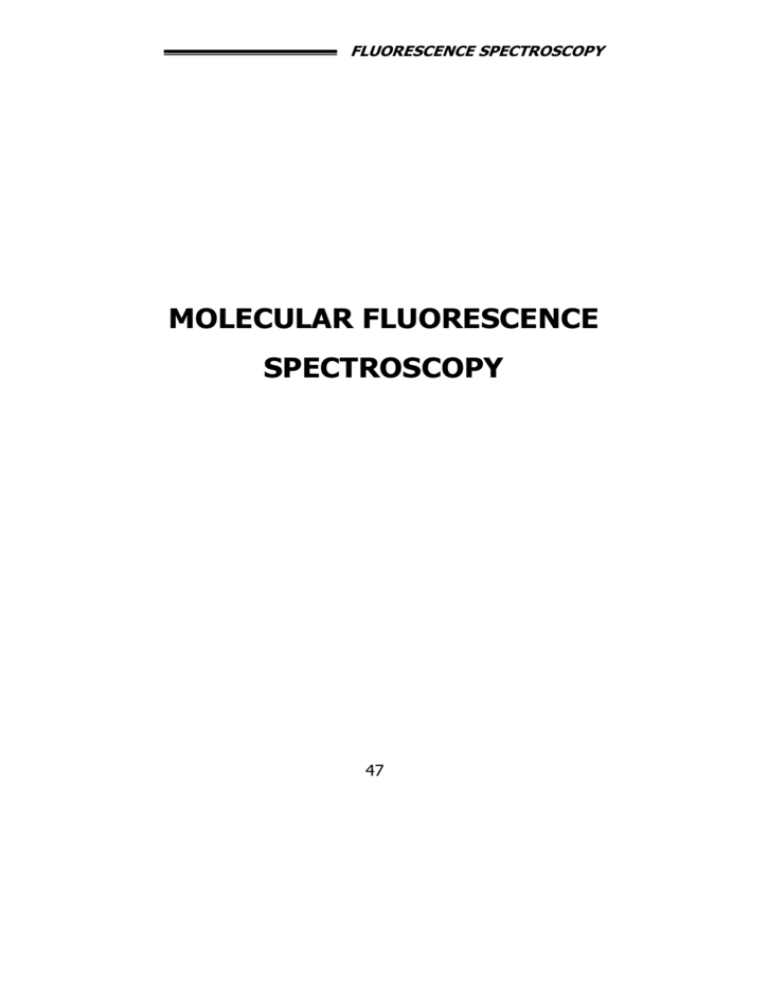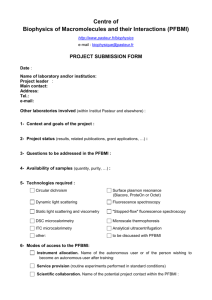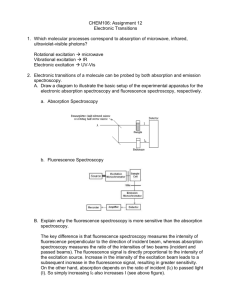MOLECULAR FLUORESCENCE SPECTROSCOPY
advertisement

FLUORESCENCE SPECTROSCOPY MOLECULAR FLUORESCENCE SPECTROSCOPY 47 FLUORESCENCE SPECTROSCOPY 48 FLUORESCENCE SPECTROSCOPY MOLECULAR FLUORESCENCE SPECTROSCOPY Fluorescence is a form of photoluminescence; and this later is a type of luminescence that occurs when certain molecules are excited by electromagnetic radiation and as a consequence remission of radiation either of the same wavelength or longer one takes place. The two most common photoluminescence are fluorescence and phosphorescence mechanisms. which are Fluorescence produced is by different distinguished from phosphorescence by the lifetime of the excited state, with fluorescence the excited state ceases immediately after irradiation is discontinued, (10-7 s), while phosphorescence continued for a detectable time (100 s). Both monoatomic particles and polyatomic molecules fluorescence, in gaseous, liquid and solid can undergo states. When the radiation absorbed is exactly the same emitted, the fluorescence is known by resonance fluorescence. Polyatomic molecules or ions exhibit resonance radiation, in addition characteristic ones of longer wavelength are emitted this phenomenon is known by Stock’s shift. Theory of molecular fluorescence: An excited molecule can return to its ground state by combination of several mechanistic steps. Deactivation or relaxation processes can be classified to radiative and nonradiative processes. Figure 1 shows the partial energy diagram for a photoluminscent system. The straight vertical arrows represent the radiative relaxation processes 49 FLUORESCENCE SPECTROSCOPY namely fluorescence and phosphorescence, where release of photons occurs. The wavy arrows are radiationless processes. The favored route to the ground state is one that minimizes the life time of the excited state. Partial energy diagram for a photoluminescent system. 50 FLUORESCENCE SPECTROSCOPY Radiationless deactivation; 1-Vibrational relaxation: A molecule may be promoted to any of several vibrational levels during the electronic excitation. In solution, the excess vibrational energy is immediately lost as a consequence of collision between the excited molecules and those of the solvent, the result is minute increase in solvent temperature. This relaxation process is very rapid (10-12 s). Accordingly, fluorescence from solutions when occurs always involves a transition from the lowest vibrational level to any vibrational levels of the ground state result in band emission. A consequence of the efficiency of vibrational relaxation is that the fluorescence band (emission spectrum) is displaced at longer wavelength (lower energy) than the absorption band (excitation spectrum) 2-Internal conversion: It is intermolecular processes by which a molecular passes from an electronic excited energy level (S2) to another lower excited energy level (S1). This occurs when the lowest vibrational energy level of S2 coincide with one of the vibrational levels of S1. 51 FLUORESCENCE SPECTROSCOPY 3-External conversion : It is deactivation of an excited electronic state which involve interaction and energy transfer between the excited molecules and the solvent or other solutes. 4-Intersystem crossing: The outer most electrons in molecular orbitals are usually even number, paired electrons with no net electron spin (diamagnetic) This molecular electronic state in which all electron spins are paired is called a singlet state (in ground state it is denoted by SO). When one of the electrons of a molecule is excited to a higher energy level a singlet or a triplet state can result. In the excited singlet state (S1 or S2) the spin of the promoted electron is paired with that in ground state; while still in the excited the electron may reverse its spin (flipping) the two electrons become unpaired and thus have the same spinning, these states can be represented as follows: SO Ground singlet S1 Excited singlet 52 T1 Excited triplet FLUORESCENCE SPECTROSCOPY A molecule with an unpaired electron in an excited level that has a spin that is identical to that of electron in the ground state, is in the triplet state. Intersystem crossing is a process in which the spin of an excited electron is reversed. The probability of this transition is enhanced if the lowest vibrational of the lowest excited singlet state are almost identical to the triplet excited state. The potential energy of the triplet state is less than that of the singlet. Intersystem crossing is common in molecules containing heavy atoms such as iodine and bromine, also it is enhanced in presence of paramagnetic molecules such as molecular oxygen. Radiative deactivation: 1- Fluorescence: As mentioned previously, an excited electron in singlet state looses vibrational energy to reach the lowest vibrational level by collision, transition from this to the ground singlet state with lose of energy in the form of photons i.e. emission of EMR; is known by fluorescence (S1or S2-S0). Also, sometimes fluorescence occurs When the electron found in an excited singlet level (S2) converted to excited singlet state but of lower energy (S1) by internal conversion, then relaxes to the ground state with emission of radiation (S1-S0) 53 FLUORESCENCE SPECTROSCOPY 2-Phosphorescence: An electron in the excited singlet state can be converted to the excited triplet state by intersystem crossing. Phosphorescence occurs when an electron in an excited triplet state relaxes to the ground singlet state while emitting radiation (T1 –S0). The considerable barrier to the spin reversal that exists in the molecule prevents intersystem crossing from occurring rapidly as singlet singlet transition. Because of that barrier phosphorescence occurs on a much longer time scale than fluorescence. Excitation and Emission Spectra: λ If the intensity of the fluorescence at one fixed wavelength (emission) λλis wavelength of the plotted as a function of radiation used to excite the fluorescence, an activation or excitation spectrum will result. This will be identical with the absorption spectrum when corrected for the instrumental effects namely variation of source out put and variation of detector sensitivity to wavelength. If we plot the intensity of fluorescence obtained when the sample is irradiated with monochromatic radiation (excitation) versus wavelength an emission spectrum is obtained. If we plot the excitation and emission spectra of a compound on the same chart the displacement of emission band to longer wavelength is apparent (Stock’s shift) and 54 FLUORESCENCE SPECTROSCOPY the two spectra bear a ‘mirror image’ relationship to each other as shown in the following figure. Excitation and fluorescence spectra of anthracene Quantum Yield : The quantum yield or quantum efficiency, () for a fluorescent process is the ratio of the number of molecules that fluoresce to the total number of excited molecules or the ratio of number of photons emitted to that absorbed. For highly fluorescent molecules it may approach one for nonfluorescent substance it approaches zero. 55 FLUORESCENCE SPECTROSCOPY Quantitative Fluorimetry and Effect of Concentration on Fluorescence: The power of the fluorescent radiation F is proportional to the radiant power of the excitation beam that is absorbed by the system. That is F= K (I0 -I) K depends upon the quantum efficiency of the fluorescence process. To relate F with the concentration c of the fluorescence particle we write Beer’s law in the form: is the molar absorptivity of the fluorescent molecules bc is the absorbance A, by substitution in the first equation F= K I0 (1- 10- bc) provided bc = A < 0.05 the exponential term of the I / I0 = 10- bc equation will be : F = 2.3 K bc I0 i.e. F = K/ c. Then a plot of fluorescent power of a solution versus concentration of the emitting species should be linear at low concentration c. When the concentration becomes great enough so that the absorbance is larger than 0.05, linearity is lost. Two other factors responsible for further departure from linearity at high concentration these are: One- Self- absorption; this occurs when the wavelength of emission overlaps an absorption peak then some of the emitted radiation will be absorbed by the molecules in solution and decrease in fluorescence takes place. Two- Self-quenching; it results from the collision of the excited molecules. 56 FLUORESCENCE SPECTROSCOPY Factors affecting fluorescence: 1- Molecular Structure: The most intense and most useful fluorescent behavior is found in compounds containing aromatic functional group. Compounds containing aliphatic and alicyclic carbonyl groups or conjugated double-bond structures may also exhibit fluorescence. Most unsubstituted aromatic hydrocarbons fluoresce the quantum yield increases with the increase of number of fused rings. The simplest heterocyclics, such as pyridine, thiophene, pyrrole and furan do not fluoresce (the lowest transition is n * system which is rapidly converted to triplet and prevents fluorescence), fusion of benzene ring in hetero atom results in fluorescent compound. Halogen substitution specially with bromine and iodine results in decrease of fluorescence due to intersystem crossing. Substitution of carboxylic acid or carbonyl group on an aromatic ring inhibits fluorescence. Fluorescence is favored in molecules that posses rigid planer structure. For example fluorene fluoresce much more intense than biphenyl due to rigidity furnished by methylene group in fluorene. The influence of rigidity is accounted for the increase of fluorescence of certain chelating agents when they form complexes with a metal ion e.g. the fluorescent intensity of 8hydroxyquinoline is much increased when it forms zinc complex. 57 FLUORESCENCE SPECTROSCOPY O Zn N C H2 Fluorene n2 Biphenyl The zinc complex 2- Temperature and Solvent Effects: The quantum efficiency of fluorescence by most molecules decreases with increasing temperature as deactivation by external conversion is favored. Also a decrease in solvent viscosity leads to the same result. Polar solvent may enhance fluorescence, while it is decreased by solvents containing heavy atoms such as carbon tetrabromide or ethyl iodide. 3- Effect of pH : The fluorescence of an aromatic compound with acidic or basic ring substitution is pH dependent. Both the emission intensity and wavelength of the ionized form and the unionized will be different. 4- Effect of Dissolved Oxygen: Being paramagnetic dissolved oxygen, decrease the fluorescence due to intersystem crossing. Instrumentation: A block diagram of the major components of single beam spectrofluorimeter 58 is shown in figure 3. FLUORESCENCE SPECTROSCOPY Electromagnetic radiation from an ultraviolet - visible source passes through a wavelength selector and through the cell (if monochromators are used the instrument is called spectrofluorimeter and if filters are used it is called fluorimeter). Emission of radiation by sample takes place in all directions. radiation The emitted is measured at 900 from the path of the exciting beam and at the center of the cell, this is to minimize the error due to scattering of light from the walls of the cell and solution, which occurs at other angles, and to prevent the interference from the exciting beam. Since a broad emission band is obtained, it is necessary to use a second wavelength selector between the sample and the detector in order to pass the most intense emitted wavelength (emission). 1-Source of energy: The source of radiation must be highly intense to allow considerable excitation. Several sources have been used, the two most commonly used are a-Mercury –arc lamp :it is a quartz lamp containing mercury vapor which upon electrical excitation emits line spectra of several definite wavelength, it can not be used when scan of spectrum is required. b- High pressure Xenon lamp emits a continuum of radiation throughout the ultraviolet -visible regions, it is useful when spectrum scanning is needed. Unfortunately the intensity of the emitted radiation varies with the 59 FLUORESCENCE SPECTROSCOPY wavelength throughout the entire range. Since the intensity of fluorescence is proportional to the excitation radiation, thus emission upon using xenon lamp, variation of intensity occurs not due to sample nature or change of concentration but due to variation in source intensity leading to erroneous results. To compensate for the variation in source intensity and also for any other instrumental variations, a double-beam instrument can be used. The following figure illustrates a block diagram of this type. A portion of the excitation energy is directed to a solution of a fluorescent standard, its fluorescence is proportional to intensity of incident radiation, and a reference signal with which the sample signal is compared, is recorded. 2-Wavelength selector: Two filters (both absorption or interference filters can be used) or monochromators (grating type) are used one between the source and the sample and the other between the sample and the detector. 3-The cell: Tetragonal or cylindrical transparent, glass or quartz tubes are used. 4-Detectors and readout meter: Photomultiplier type is used since the intensity of emitted radiation is small. Digital or analog or nullpoint meter are used. 60 FLUORESCENCE SPECTROSCOPY Schematic diagram of an instrument to measure fluorescence radiation Schematic diagram of a typical spectrofluorometer 61 FLUORESCENCE SPECTROSCOPY Application of Fluorimetry: Compounds which are intrinsically fluorescent are easily determined at very low concentration by simple fluorimetric method, for example, phenobarbitone, quinine, emetine, adrenaline, cinchonine, reserpine vitamin A, riboflavine………and many other pharmaceuticals and natural products. Also, nonfluorescent substances can be determined after chemical reaction. Inorganic ions can be determined either by formation of fluorescent chelates upon reaction with fluorimetric reagents e.g. 8- hydroxyquinoline (for Al), benzoin (for Zn) or flavanol (for Zr) or by measuring the quenching of fluorescence of a fluorescent substance in presence of some ions. 62








